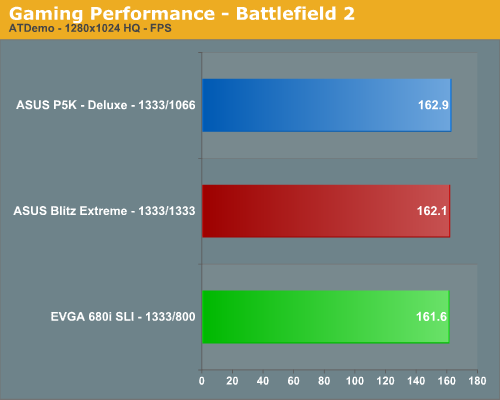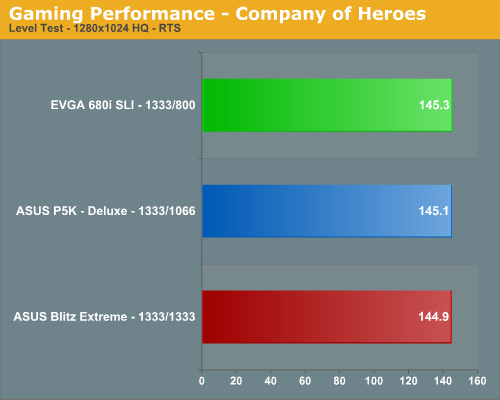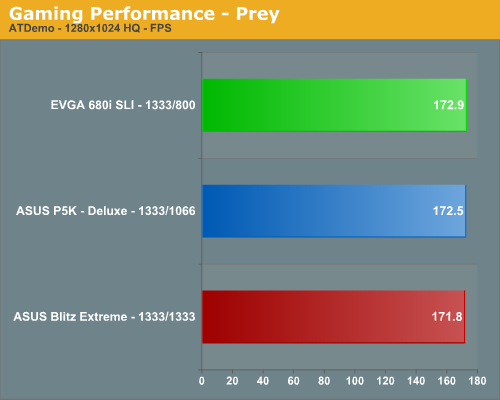NVIDIA 680i SLI: Official 1333MHz FSB CPU Support Arrives
by Gary Key on July 20, 2007 12:01 AM EST- Posted in
- CPUs
Gaming Performance:
We ran benchmarks with our standard 1280x1024 resolution with all games set to High Quality mode. Given the number of users that run 19" LCDs these days, 1280x1024 represents one of the most commonly used resolutions and it also ensures our comparisons are not GPU limited.
Battlefield 2
This benchmark is performed using DICE's built-in demo playback functionality with additional capture capabilities designed in house. When using the built-in demo playback features of BF2, frames rendered during the loading screen are counted in the benchmark. In order to get a real idea of performance, we use the instantaneous frame time and frames per second data generated from our benchmark run. We discard the data collected during the loading screen and calculate a result that represents actual game play. While DICE maintains that results over 100fps aren't always reliable, our methods have allowed us to get useful data from high performing systems.

Company of Heroes
Company of Heroes is still proving to be a very addictive RTS game around the office. The game is extremely GPU intensive and also requires a hefty CPU at times. The game contains a built-in performance test that utilizes the game engine to generate several different action scenes. We found the performance test gives a good indication of how well your system will perform throughout the game on average. We have found some of the in-game action sequences to be more demanding than the performance test and are working on game play benchmark that is repeatable. We generally found the game to be enjoyable with an average frame rate above 35fps.

Prey
Prey offers some superb action sequences, unique weapons and characters, and is a visually stunning game at times. It still requires a very good GPU to run it with all of the eye candy turned on. We set all graphic settings to their maximum except for AA/AF and utilize a custom timedemo that takes place during one of the more action oriented sequences. We generally found the game to be enjoyable with an average frame rate above 35fps.

Gaming Summary
The NVIDIA 680i chipset has always been a top performer in gaming and this trends continues in our limited test suite. Although the performance differences between the boards are extremely minor, we see the EVGA 680i taking the top score in two of the benchmarks. This is reversal from previous P35 test results that utilized an AMD HD 2900XT card. Still, gaming performance is driven by the GPU, especially in the latest titles, but every extra bit of performance always helps.
We ran benchmarks with our standard 1280x1024 resolution with all games set to High Quality mode. Given the number of users that run 19" LCDs these days, 1280x1024 represents one of the most commonly used resolutions and it also ensures our comparisons are not GPU limited.
Battlefield 2
This benchmark is performed using DICE's built-in demo playback functionality with additional capture capabilities designed in house. When using the built-in demo playback features of BF2, frames rendered during the loading screen are counted in the benchmark. In order to get a real idea of performance, we use the instantaneous frame time and frames per second data generated from our benchmark run. We discard the data collected during the loading screen and calculate a result that represents actual game play. While DICE maintains that results over 100fps aren't always reliable, our methods have allowed us to get useful data from high performing systems.

Company of Heroes
Company of Heroes is still proving to be a very addictive RTS game around the office. The game is extremely GPU intensive and also requires a hefty CPU at times. The game contains a built-in performance test that utilizes the game engine to generate several different action scenes. We found the performance test gives a good indication of how well your system will perform throughout the game on average. We have found some of the in-game action sequences to be more demanding than the performance test and are working on game play benchmark that is repeatable. We generally found the game to be enjoyable with an average frame rate above 35fps.

Prey
Prey offers some superb action sequences, unique weapons and characters, and is a visually stunning game at times. It still requires a very good GPU to run it with all of the eye candy turned on. We set all graphic settings to their maximum except for AA/AF and utilize a custom timedemo that takes place during one of the more action oriented sequences. We generally found the game to be enjoyable with an average frame rate above 35fps.

Gaming Summary
The NVIDIA 680i chipset has always been a top performer in gaming and this trends continues in our limited test suite. Although the performance differences between the boards are extremely minor, we see the EVGA 680i taking the top score in two of the benchmarks. This is reversal from previous P35 test results that utilized an AMD HD 2900XT card. Still, gaming performance is driven by the GPU, especially in the latest titles, but every extra bit of performance always helps.










18 Comments
View All Comments
TA152H - Saturday, July 21, 2007 - link
I see this Asus Blitzkrieg Extreme, but what it is? It kind of gets thrown in there with no explanation, but I can't find anything that describes it, or any mention of it on Asus's website.Don't you think you should have at least mentioned what this thing is? I mean, I gathered it's a P35 DDR3 motherboard, but then so is the P5K3. So, obviously something is different, but no explanation is given.
Chunga29 - Sunday, July 22, 2007 - link
What's an ASUS Commando? Originally it was a P5B Deluxe plus $150. I would guess the Blitzkrieg is about the same: tuned for a bit higher OCing, but really just a more expensive mobo that isn't necessary for 99% of users.Review forthcoming, I'd assume, Gary?
TA152H - Saturday, July 21, 2007 - link
Show me someone with a Nvidia chipset for Intel processors, and I'll show you an idiot. Why would anyone in their right mind even consider a non-Intel chipset, except for real low power uses (which even Intel does for some of their motherboards, from SIS). Intel easily makes the best chipsets and more importantly they are the standard and almost as importantly are extremely well supported by the parent company.Nvidia is fine for a minor company like AMD that can't make a decent chipset, or hasn't chosen to, but for Intel that makes a much broader line of products, which are not only excellent but extremely well supported, Nvidia makes no sense at all. It's not only that, they don't manufacture their products, and now that Intel is moving their chipsets to more modern manufacturing processes, it's obvious they are taking them very seriously.
It's a good review though, just so everyone can see there is no point in Nvidia. Otherwise, there would be those lingering doubts.
ATWindsor - Saturday, July 21, 2007 - link
Theese are extremly seriuos problems with a motherboard, why not focus abit more on functionality and stability and less on overclocking in the reviews, so the users won't get theese nasty suprises?AtW
rjm55 - Friday, July 20, 2007 - link
nVidia can crow all they want about 1333 support, but the fact is their dhipsets don't support DDR3. With the new DDR3-1600, DDR3-1666, and DDR3-2000 low latency parts that have started shipping, nVidia has nothing to crow about. DDR2 has just become obsolete with these new DDR3 parts and nVidia can only handle DDR2. Guess these expensive boards will soon be on closeout at Newegg.TA152H - Saturday, July 21, 2007 - link
I agree, but they probably needed to do nothing to this part, just say it runs at 1333 MHz and thus is compatible with the newer products.Clearly they need a DDR3 chipset, but then again, what is the point of Nvidia chipsets for Intel processors anyway? It's not like Intel's aren't fantastic, or that they overprice them. I don't see any value-add to Nvidia in this space, they take too much power and offer essentially nothing. But, if they insist on staying, they need to get DDR3 out and fast. DDR2 is obsolete, and their chipsets thus are as well.
DigitalFreak - Friday, July 20, 2007 - link
ROFLMAO! You have become obsolete.Here's your sign.
Owls - Friday, July 20, 2007 - link
We lined up several 600i motherboards on the test bench, popped our QX6850 in each one, flipped the switch, and then took several deep breaths as board after board failed to run properly. A couple of boards would not even POST, a few worked fine, and some would boot into Vista and then act strange - not Britney Spears strange mind you; more like Paris Hilton behind bars. You just knew that QX6850 wanted to escape its confines and party all night long, but instead it was limited to a few whimpers and constant pleas for help from its socket induced hell.Get to the point. You don't get +1s for being funny in a professional article, what a joke.
gigahertz20 - Friday, July 20, 2007 - link
Go somewhere else then if you don't like a little humor in the articles. I thought it was funny and plus it's not like we pay to read Anandtech articles, so stop bitching about something you get for free.JKing76 - Friday, July 20, 2007 - link
I notice that this is not a micro-ATX roundup. I notice that a week has elapsed from the specific day we were told the roundup would start. And of course, everyone in the uATX Results thread has noticed that we've been jerked around for three months about this supposed review.